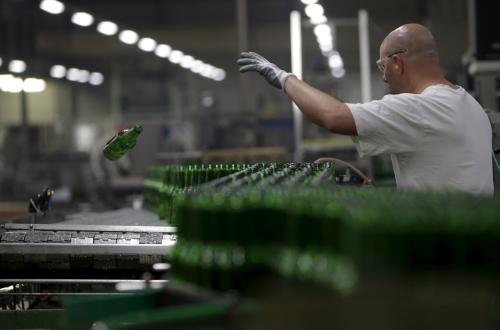Congress cut the tax on wine, beer and liquor in 2017 in the big Tax Cuts and Jobs Act – but only for two years. The industry and its bipartisan cast of allies in Congress are now mounting an effort to extend the tax cuts or even make them permanent. Their rhetoric is at odds with reality, and the bill would benefit from changes before passage.
What is the Craft Beverage Modernization Act?
The Craft Beverage Modernization and Tax Reform Act (part of the TCJA) expires this year. It is described as helping small, craft producers, but the vast majority of its tax cuts go to large distillery corporations and foreign spirits importers, ballooning the cost of the bill, undercutting the ability of truly small businesses to compete, and threatening public health.
A loophole in the Act allows large producers of distilled spirits to ship their product tax free through smaller firms, importers, or even shell company intermediaries, allowing them to claim the lower tax rate that was supposed to be reserved for small, craft businesses. According to estimates from the Joint Committee on Taxation, updated to reflect what they’ve learned from the tax cut’s first-year impacts, most of the $1.2 billion cost of a one-year extension of the bill is associated with producers of distilled spirits who use this loophole, rather than true craft distillers, or beer and wine producers of any size.
Congress could retain the low tax rates that apply to true craft businesses, but should close the loophole and incentives for tax avoidance. This would retain the benefits for small firms, insulate them from unfair competition from companies gaming the new rules, and reduce the cost of making the low craft rates permanent. It would also help ensure that the tax cuts don’t result in dramatically lower prices for generic alcoholic products, which public health researchers find contributes to motor vehicle accidents, violence (including domestic abuse), and other costs to health from dependence and abuse.
Who benefits from the tax breaks?
The 2017 law lowered the tax rates on beer, wine, and distilled spirits. For instance, the excise tax rate on distilled spirits was reduced by 80 percent, from $13.50 per proof gallon (a gallon of spirits that is 50 percent alcohol) to $2.70. That’s a decline from about $2.14 per bottle to $0.43 per bottle of 40 proof spirits. Reductions in taxes on beer and wine were smaller.
To focus the benefits on craft producers, the low rate was intended to apply only to the first 100,000 gallons of distilled spirits produced by each company. In 2017, small producers—those producing less than 100,000 proof gallons per year—sold about 2 percent of all distilled spirits in the US.
However, the 77 largest companies that produce more than 100,000 gallons per year in 2017 also benefitted from lower taxes on their first 100,000 gallons. (Indeed, based on 2017 production, those 77 firms would have received 61 percent of the tax cut for “craft” producers.) If that were the end of the story, the total tax cut would be small. That’s because the first 100,000 gallons produced at the largest 77 companies represents only 2 percent of all spirits (slightly more than the total amount produced by all craft producers combined). Hence, the tax cut only should have applied to about 4 percent of all spirits.
But that’s not the end of the story. Instead, tax experts (and federal revenue estimators) believe that as much as a third of all distilled spirits consumed in the U.S. might qualify for the break, almost all of it produced by large domestic corporations or imported from abroad. As a result, almost 75 percent of the entire cost of the Craft Beverage Act went to distilled spirits producers, but only about 6 percent benefitted craft distillers.
One reason is that the law allows for transfers of distilled spirits between producers without payment of tax. For instance, a large industrial producer can ship 100,000 gallons of distilled spirits out of its own warehouse to the warehouse of a smaller producer or intermediary. In doing so, the company reduces the tax on that alcohol from $1.35 million to $270,000. The small producer doesn’t even need to distill its own spirits, it just needs a Treasury permit.
Tax experts believe that as much as a third of all distilled spirits consumed in the U.S. might qualify for the break, almost all of it produced by large domestic corporations or imported from abroad.
Similarly, the first 100,000 gallons imported by an importing company qualifies for the break. That allows foreign producers (or domestic resellers) to divide their products among multiple importers to keep the volume at each below the 100,000 threshold. While Treasury rules may attempt to prohibit such behavior, in practice, Treasury and Customs officials have no ability or authority to police such activities that occur outside of our borders.
Because the tax savings is $1,080,000 per year for each shell “distillery” or each importer bringing in 100,000 gallons of spirits, the incentives to find and exploit these loopholes are lucrative.
Indeed, it’s clear that such practices happen all the time. How can craft distilleries that have opened in the last few years offer 21-year aged whiskies? Or sell thousands of cases of spirits despite showcasing a small, rarely operated still? No doubt, some will argue that some of those producers are applying real artisanal skill in, say, blending aged whiskies, but the question is whether we should offer the same tax cuts for those who sell blended vodkas in plastic bottles? Today, anyone can get a permit to operate a private-label “distillery” using only spirits produced elsewhere and save almost $2 a bottle in taxes.
Indeed, the law almost seems to be drafted for the benefit of those who would engage in these practices. Aside from the reduced rates, the key amendments to the law (in Section 5212) make it easier to transfer spirits from large producers to smaller intermediaries. Before the reform, for instance, when one firm wanted to ship spirits to another, they were required to ship in bulk. Now they’re allowed to ship it right in the bottle.
How to close the loopholes
So what’s the solution? The simplest, most effective, and most cost-effective approach would be to reduce the amount of distilled spirits that benefits from the low rate to 10,000 proof gallons (from 100,000 gallons). Of the 3,053 permitted distilleries in 2018, 2,825 (93 percent) produced less than 10,000 gallons. Were the threshold reduced such that only the first 10,000 proof gallons qualified for the low rate, the tax cuts would be more concentrated among real small, craft producers, the total cost of the legislation would be substantially reduced, and the incentive and opportunities for larger producers and foreign importers to exploit the loophole tax would be smaller. But for 93 percent of distilleries, the tax consequences would be unchanged.
A related (but less effective) approach is to eliminate or modify the Code Section (IRC 5212) that allows for transfers of spirits in bond between producers. These rules allow a large producer to ship alcohol tax free to the small “producer”, where the tax is then applied at the small producer rate. Prohibiting such transfers and taxing the alcohol at the original distiller’s rate would stop alcohol produced at large factories from benefiting from the “craft” rate. Alternatively, Congress could amend IRC 5212 (and similar provisions for wine and beer) to allow transfers in bond but requiring that subsequent taxable withdrawals be taxable at the tax rate of the original producer—i.e., mandate that spirits distilled by a large producer be taxed at the rate that applies to large producers. That would allow producers to transfer in bond and defer the tax, but without generating perverse and costly incentives driven by the tax savings. Finally, Congress could also limit who qualifies for a permit as a “producer” making it clearer that “producer” applies to businesses that actually distill spirits, but not to those that bottle, age, blend, flavor, or otherwise do not distill the alcohol themselves. This would narrow the scope for how much alcohol qualifies. However, the changes in this paragraph would still allow foreign producers and importers to access low rates and are thus less effective than simply reducing the threshold at which the lower craft rates apply from 100,000 gallons to 10,000 gallons.
With these changes, Congress can close the loopholes that increase the cost of the bill, benefit larger producers and foreign importers, and contribute to alcohol dependence and abuse, and thereby produce a bill whose benefits are concentrated on real craft producers, the ones that Congress said it wanted to help when it passed the 2017 tax cut.





Commentary
How to close the loopholes in the Craft Beverage Modernization Act
September 6, 2019